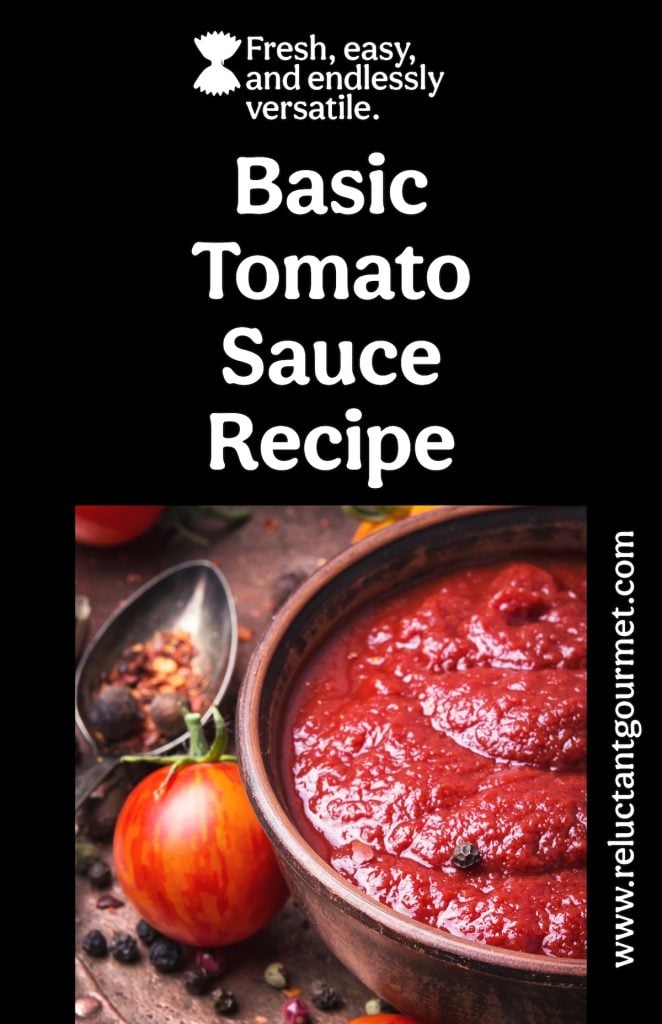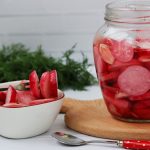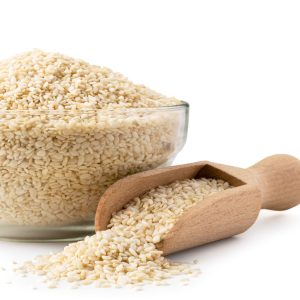How to Prepare Quick Pickled Garnishes
I don’t know about you, but I don’t add enough garnishes to my dishes. What I recently learned is how to prepare quick pickled garnishes to make my dishes look and taste better.
We might have added some toasted pine nuts or sesame seeds to a dish, but that’s about it until we started cooking Blue Apron dinners. These guys add garnish to everything.
We have been big fans of Blue Apron for a while but now that we have to stay home, it has been extremely helpful to have those two or three meals come each week. Yes, there are pro and cons to have a service like Blue Apron or Hello Fresh or Home Chef but that’s for another post.
Why Add a Garnish to a Recipe?
I like to add a garnish because it makes the plate look more appetizing but there are several more reasons to add them.
- Visual appeal – before you get to smell or taste food, you see it. Adding a garnish can make dish draw your eye to the plate typically by adding color or texture.
- Flavor appeal – not only can a garnish make a dish look better, it can also make it taste better. I’m going to talk about pickled garnishes in this post and I’ve come to love the flavor of them including just munching on them as I’m preparing the dish.
- Fills the Plate – This is not true for every meal you prepare but some dishes, especially in fancy restaurants, can be minimal, like a small portion of grains topped with some protein and maybe a vegetable on the side leaving the plate empty. Here a garnish can break up the plate or add balance to it.
- Seasoning – A common garnish on most seafood dishes is a wedge of lemon. Not only does the bright yellow color of a lemon give the meal an appetizing look, it’s there so you can squeeze some lemon juice onto the fish for seasoning.
Pickled Garnish
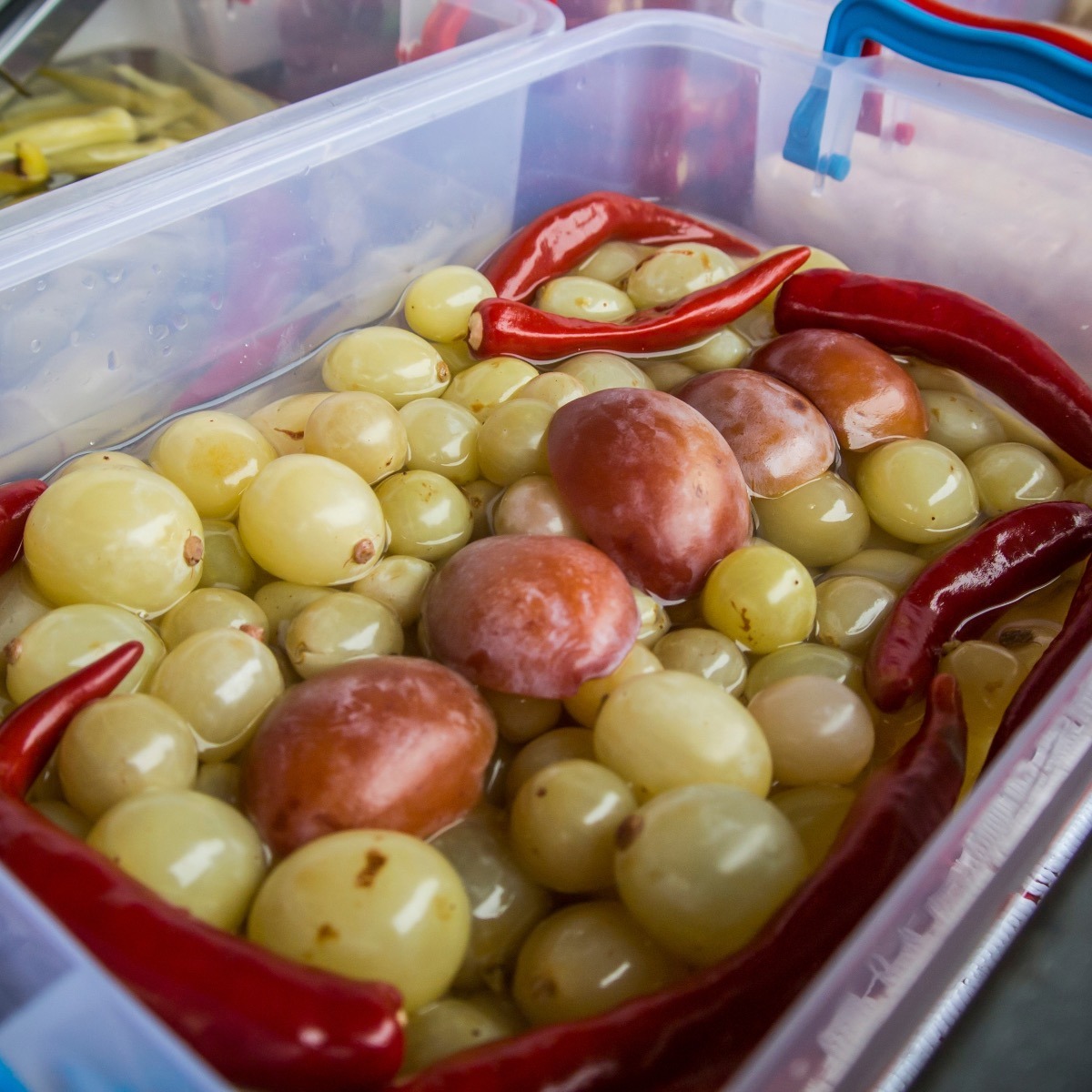
You can pickle just about anything but some of the ingredients I’ve pickled for Blue Apron recipes include radishes, onion, cucumbers and cabbage. Doing some research on the Internet, I’m finding recipes for pickling peppers, ginger, turnips, carrots plus fruits like blueberries and strawberries.
What is Pickling?
Pickling is a process to preserve food by way of brine or vinegar. The most popular example of pickling is a pickle but history shows pickling goes way back in time as early a 2400 BCE in India.
The two most common ways of pickling is by brine fermentation or immersion in vinegar. The process not only preserves the ingredient but changes its taste and flavor. A pickled cucumber tastes so much different that a non-pickled cuke. Both are good but different.
Today, there is a lot of talk about the health benefits of pickled foods. You hear about the benefits of eating fermented foods because they are full of probiotics that are good for your stomach.
How Long Does It Take to Pickle Something?
Depends on what process you are using for pickling. If you are fermenting your ingredients in a salt water brine, it can take days or weeks for the fermentation process to complete its task.
If you are pickling in vinegar, it can take as little as ten minutes or up to 5 days depending what you are pickling and what you are using to do the job. The pickling I’m talking about for this post is quick and easy and can be done while you are preparing the rest of the meal.
To learn more about pickling, check out this site – How to Pickle.
Did you know Americans eat more than 2.5 billion pounds of pickles each year?
“In a Pickle”
We’ve all heard the expression being “in a pickle” and know it to mean being in a difficult situation but do you know where this idiom comes from? If you do, let me know because I’ve been looking all over the Internet and have not found a reliable meaning.
The best history I’ve found is from Bon Appetit and includes the Dutch expression “in de pekel zitten” and Shakespeare’s “How camest thou in this pickle?”.
The author concludes the expression comes from the English use of the word “pickle to refer to what any American hot dog vendor would call “relish”…..Like the veggies in the relish, if you’re in a pickle, you’re in a state of jumbled disarray.”
Pickled or Marinated
If you marinate sliced cucumbers in a mixture of vinegar and a little bit of oil, is that pickling? I would say yes.
This week I marinated diced Persian cucumbers in apple cider vinegar with a touch of olive oil, salt & pepper and let them sit for 10 minutes. I would call these pickled diced cucumbers.
A few weeks ago I combined vinegar, garlic, sugar and water in a small pot and brought it to a boil for a couple of minutes and then let it cool. I poured this into a bowl with sliced radishes and cucumber and let it sit for 10 minutes. I would call this pickled radish and cucumbers.
Both made great garnishes for the dishes we were preparing, providing color and a wonderful layer of flavor.
Pickled Radishes
Ingredients
- 3 ounces radishes
- 1 tablespoon rice vinegar
- 1 tablespoon sesame oil
- salt and pepper to taste
Instructions
- Slice the radishes in half lengthwise and then thinly slice them crosswise. Transfer to a small bowl.
- Add the vinegar and sesame oil, season with salt and pepper and stir to coat.
- Let this sit for at least 10 minutes then serve as garnish.
Simple Marinated (Pickled) Cucumbers
Ingredients
- ¼ garden cucumber
- 2 tablespoons rice vinegar
- salt and pepper to taste
Instructions
- Cut the cucumber in half length wise and then thinly slice crosswise. Transfer to a bowl.
- Add the vinegar, season with salt and pepper and toss to coat.
- Let this sit for at least 10 minutes, stirring every once in a while.
- Use as a garnish.
Notes

Pickled Radishes
Ingredients
- 3 ounces radishes
- 1 tablespoon rice vinegar
- 1 tablespoon sesame oil
- salt and pepper to taste
Instructions
- Slice the radishes in half lengthwise and then thinly slice them crosswise. Transfer to a small bowl.
- Add the vinegar and sesame oil, season with salt and pepper and stir to coat.
- Let this sit for at least 10 minutes then serve as garnish.
Pickled Radishes and Cucumber Recipe
Ingredients
- 2 cloves garlic
- 3 ounces radishes about 4
- 2 Persian cucumbers or ⅓ English cucumber
- 2 tablespoons rice vinegar
- 1 tablespoon sugar
- 1½ teaspoons brown & yellow mustard seeds
- ¼ cup water
- salt and pepper to taste
Instructions
- Peel the garlic and smash it carefully with the flat side of a chef's knife or with a small pot.
- Cut the ends off the radishes and thinly slice them.
- Halve the cucumbers lengthwise and thinly cut crosswise.
- In a small sauce pot, combine the smashed garlic, vinegar, sugar, mustard seeds and ¼ cup of water.
- Bring to a boil and cook for a couple of minutes while stirring until the sugar dissolves. Remove from heat.
- In a small bowl, add the radishes and cucumbers and cover with the marinade.
- Let sit for at least 10 minutes. Taste and adjust seasoning with salt and pepper.
- Serve as garnish.
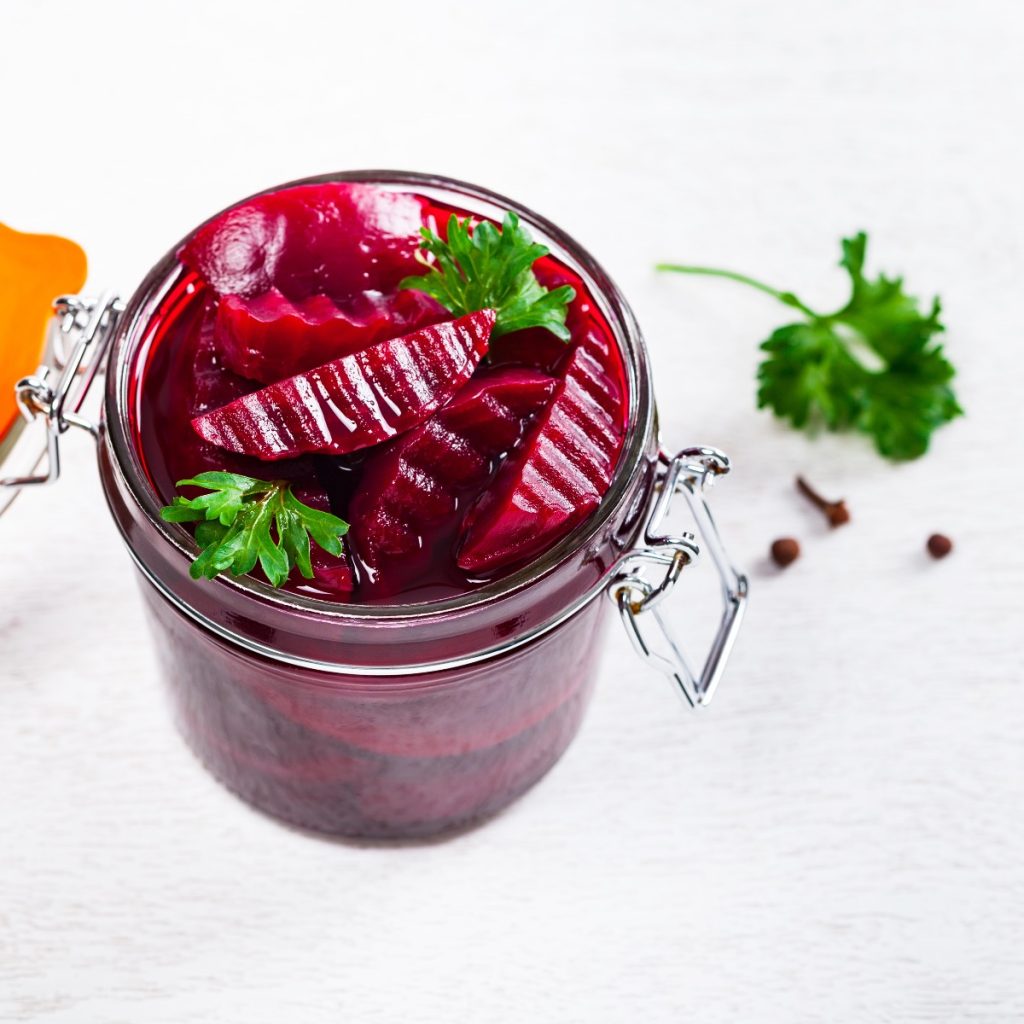
Quick Pickled Beets
Ingredients
- 4 ounces cooked beets diced
- 2 tablespoons white vinegar
- 1 teaspoon sugar
- ¼ cup water
- salt and pepper to taste
Instructions
- Dice the cooked beets, small dice is best.
- In a small saucepan, combine the vinegar, sugar and water. Bring to boil and cook for 1 minute until the sugar is dissolvede. Stir frequently.
- Remove from heat.
- In a small bowl, add the diced beets and pour the vinegar/water mixture over them. Stir to cover beets.
- Let sit for at least 10 minutes remembering to stir every once in a while.
- Serve as garnish.

Pickled Shallots for Garnish
Ingredients
- 1 shallot peeled and sliced thin
- 2 tablespoons apple cider vinegar
- 1 tablespoon sugar
- ¼ cup water
- salt and pepper to taste
Instructions
- Slice the peeled shallot into thin slices. Transfer to a small bowl.
- In a small sauce pan, combine the vinegar, sugar and ¼ cup of water. Season with salt and pepper.
- Bring the mixture to a boil and cook for one minute until the sugar dissolves. Stir frequently.
- Remove from heat and pour mixture over the reserved shallots.
- Let sit for at least 10 minutes for the shallot to pickle.
- Taste and adjust seasoning with salt and pepper.
- Serve as garnish.
Quick Pickled Grapes
Ingredients
- 2 ounces red seedless grapes sliced
- 2 tablespoons white wine vinegar
- 1 tablespoon sugar
- 1 pinch salt
Instructions
- Cut the grapes into slices
- Combine the vinegar, sugar and salt in a small bowl.
- Stir to combine ingredients and the sugar dissolves.
- Add the sliced grapes to the bowl and stir to combine.
- Let this sit for at least 10 minutes to pickle the grapes.
- Serve as garnish.


